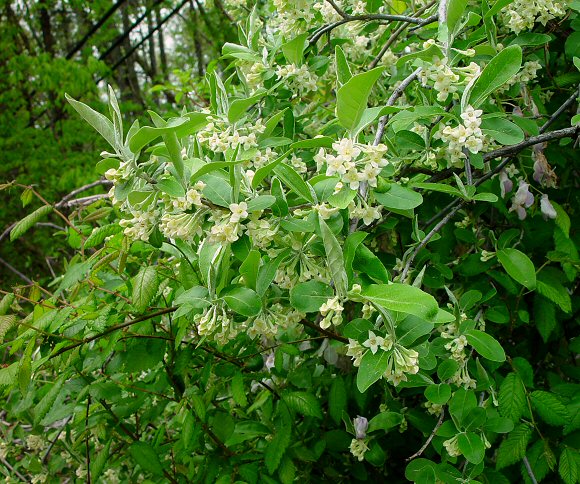Elaeagnus umbellata Thunb.
Autumn Olive

Introduced
CC = *
CW = 5
MOC = 43
© DETenaglia
Elaeagnus umbellata Thunb.Autumn Olive | |
 |
Introduced CC = * CW = 5 MOC = 43 |
© DETenaglia |
|
Family - Elaeagnaceae Habit - Shrubs to 3 m, usually multiple-stemmed, rarely with a few thorns. Stems - Bark gray to reddish brown, the younger branches densely covered with both rusty and silvery scales. New growth shiny silver due to dense scales.
Leaves - Alternate, simple, entire, petiolate. Petioles to 1 cm long, densely scaly, with a shallow adaxial groove. Leaf blades 30-80 mm long, 10-40 mm wide, narrowly elliptic to elliptic, silvery beneath, green above even when young, the silvery undersurface with at least a few scattered, rusty scales.
Inflorescence - Axillary umbellate clusters. Pedicels to 5 mm long in flower, densely scaly. Flowers - Perfect or functionally unisexual, 6-8 mm long, deeply perigynous, the receptacle elongated into a tubular hypanthium with a pronounced constriction just above the ovary (which thus appears inferior), the nongreen portion above the ovary shed before fruiting. Hypanthium (beyond the constricted area above the ovary) 2 or more times as long as the sepals, silvery with scales on the outer surface, the sepals cream-colored to yellow on the inner surface. Sepals 4, petaloid, spreading, similar in texture to the hypanthium, with stellate hairs at the tips. Stamens 4, attached near the tip of the hypanthium alternating with the sepals, the filaments very short. Petals absent. Ovary superior, 1-locular, with 1 ovule. Style 1, linear, with the stigma a linear area along the side toward the tip. Flowers very fragrant.
Fruits - Mature fruits short-stalked (to 5 mm), 5-8 mm long, circular in outline, more or less translucent, red, with scattered, rusty scales appearing as tiny dots to the naked eye.
Flowering - April - June. Habitat - Upland forests, prairies, sand prairies, glades, savannas, streambanks, fields, pastures, fencerows, roadsides, and open, disturbed areas. Sometimes cultivated. Origin - Native to Asia. Other info. - This species is found throughout Missouri and most of the eastern half of the U.S. It is recognized by the dense covering of silvery scales on the leaf undersurfaces, with a few to many rusty scales also present. The masses of tubular white flowers in spring emit a fragrance which can be detected from several meters away. The spherical fruits are distinctive, with a covering of scales which appear as small dots to the naked eye. Like legumes, the plant fixes nitrogen from the air, improving the soil. Photographs taken off Hwy 29, Guilford County, NC., 4-20-03, and at the Kansas City Zoo., 7-12-99 (DETenaglia); also at Little Lost Creek Conservation Area, Warren County, MO, 3-30-2012; near Goodrich, Genesee County, MI, 7-03-2022; and at Woodson K. Woods Conservation Area, Crawford County, MO, 8-08-2023 (SRTurner). |